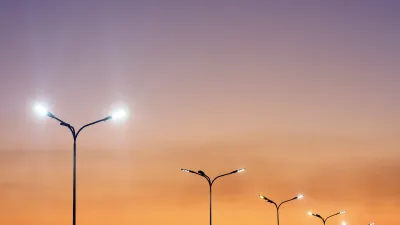For only $155,000 a light sculpture has helped transform Stamford, Conn.'s unloved train station - “a building that has a harshness almost unequaled in contemporary architecture” - into a pulsating beacon "reminiscent of a Mondrian" painting.
It's pretty amazing what a few light-emitting diodes (LEDs) can do to our most pedestrian pieces of infrastructure. In Stamford, Connecticut a $155,000 grant intended to bring art to outdoor spaces has done wonders for the city's "drab" train station, reports Alison Leigh Cowan. "City Hall used its $155,000 grant as kindling for a competition that did not ask applicants to tear down or remodel the unattractive building so much as reimagine it as a large blank canvas."
Cowan explains the design, which was conceived by Sandy Garnett, a sculptor and painter, with a team that included "Joy Wulke, an environmental artist who runs Projects for a New Millennium; Steve Hamelin, a lighting expert who toured with Bruce Springsteen and Michael Jackson; and Jamie Burnett, an electrician well versed in theatrical design."
"Flexible, light-emitting diode strips — 1,275 feet in all — have been mounted along three sides of the building, which overlooks Interstate 95. At night, the strips offer a riot of colors that is complemented by 24 lights that are beamed onto the walls from across the street."
"Other cities like New Britain commissioned traditional outdoor art like murals with their awards," notes Cowan. "Stamford, however, asked applicants to suggest ways of using light because it is a more playful medium."
"Applicants recalled that they had their work cut out for them, and not just because of the limited budget. 'I always said it looked like something in Minsk,' Stamford’s director of economic development, Laure Aubuchon, said of the station, which she passes through twice daily as a reverse commuter. 'Which is probably insulting Minsk.'”
FULL STORY: At Sundown, Train Station Trades In Drab for Dazzling

Planetizen Federal Action Tracker
A weekly monitor of how Trump’s orders and actions are impacting planners and planning in America.

San Francisco's School District Spent $105M To Build Affordable Housing for Teachers — And That's Just the Beginning
SFUSD joins a growing list of school districts using their land holdings to address housing affordability challenges faced by their own employees.

The Tiny, Adorable $7,000 Car Turning Japan Onto EVs
The single seat Mibot charges from a regular plug as quickly as an iPad, and is about half the price of an average EV.

Even Edmonton Wants Single Staircase Buildings
Canada's second most affordable major city joins those angling to nix the requirement for two staircases in multi-family buildings.

Duffy Threatens to Cut DOT Funds to “Sanctuary Cities”
“Follow the law or forfeit the funding” says US Secretary of Transportation.

Trump Approves Futuristic Automated Texas-Mexico Cargo Corridor
The project could remove tens of thousands of commercial trucks from roadways.
Urban Design for Planners 1: Software Tools
This six-course series explores essential urban design concepts using open source software and equips planners with the tools they need to participate fully in the urban design process.
Planning for Universal Design
Learn the tools for implementing Universal Design in planning regulations.
Smith Gee Studio
City of Charlotte
City of Camden Redevelopment Agency
City of Astoria
Transportation Research & Education Center (TREC) at Portland State University
City of Camden Redevelopment Agency
Municipality of Princeton (NJ)




























